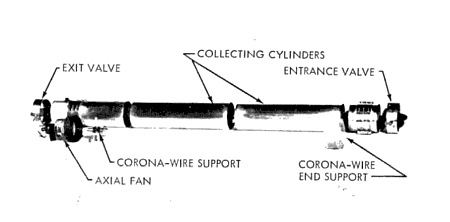Purpose of the flight and payload description
This balloon flight was part of a series of experimental miissions to determine the feasibility of an electrostatic precipitator sampler designed by Del Electronics Corporation for the U.S. Atomic Energy Commission (USAEC).
Test were were conducted in Minneapolis, Minnesota, and San Angelo, Texas, during the period from October 1961 to June 1963.
The sampler was designed to collect stratospheric aerosols in the region of 70,000 to 135,000 ft for radiochemical analyses. It consisted of an aluminum cylinder 6 inch in diameter and 4 feet long with an axial corona wire. Air was drawn through the cylinder by a battery-operated axial-vane fan at a rate of either 100 or 200 ambient cubic feet per minute. The basic components of the sampler are shown at left. Collection was made on an aluminum-foil liner coated with a colloidal graphite suspension on the inner surface of the cylinder. The total collection-surface area was 6 square feet.
A half an inch strip along the liner in the direction of air flow was not coated so that, prior to each flight, carbon-coated electron-microscope specimen grids could be mounted at intervals along the liner. This was done as an adjunct to the main purpose of the flight tests in the hope that a sufficient number of particles would be collected for study.
In the first tests, the electron-microscope grids were taped to the clean aluminum surface, but in later flights the uncoated strip was eliminated, and the grids were attached with a small amount of the colloidal graphite suspension.
The precipitator was equipped with butterfly valves at each end to prevent the entry of air from the time that the balloon was launched until the sampling altitude was reached. The valves did not provide an airtight seal, however. At the end of the 3 to 4 hour sampling period at a fixed altitude, the butterfly valves were closed, and the sampling unit was released from the balloon to return to earth by parachute. Upon recovery the precipitator was capped at both ends with polyethylene bags and then returned to the launch site, where the precipitator was dismantled and the sections containing the liner, along with the electron-microscope grids, were removed and sent to the Health and Safety Laboratory, USAEC.
Details of the balloon flight
Balloon launched on: 8/0/1961
Launch site: University of Minnesota Airport, New Brighton, US
Balloon launched by: General Mills Inc.
Balloon manufacturer/size/composition: Zero Pressure Balloon
Flight identification number: GMI-2556
End of flight (L for landing time, W for last contact, otherwise termination time): 8/0/1961
External references
- Particle size distribution of stratospheric aerosols at 110.000 ft in Radioactive Fallout from Nuclear Weapons Tests, USAEC Conference 1964, Pag. 134
14295If you consider this website interesting or useful, you can help me to keep it up and running with a small donation to cover the operational costs. Just the equivalent of the price of a cup of coffee helps a lot.


